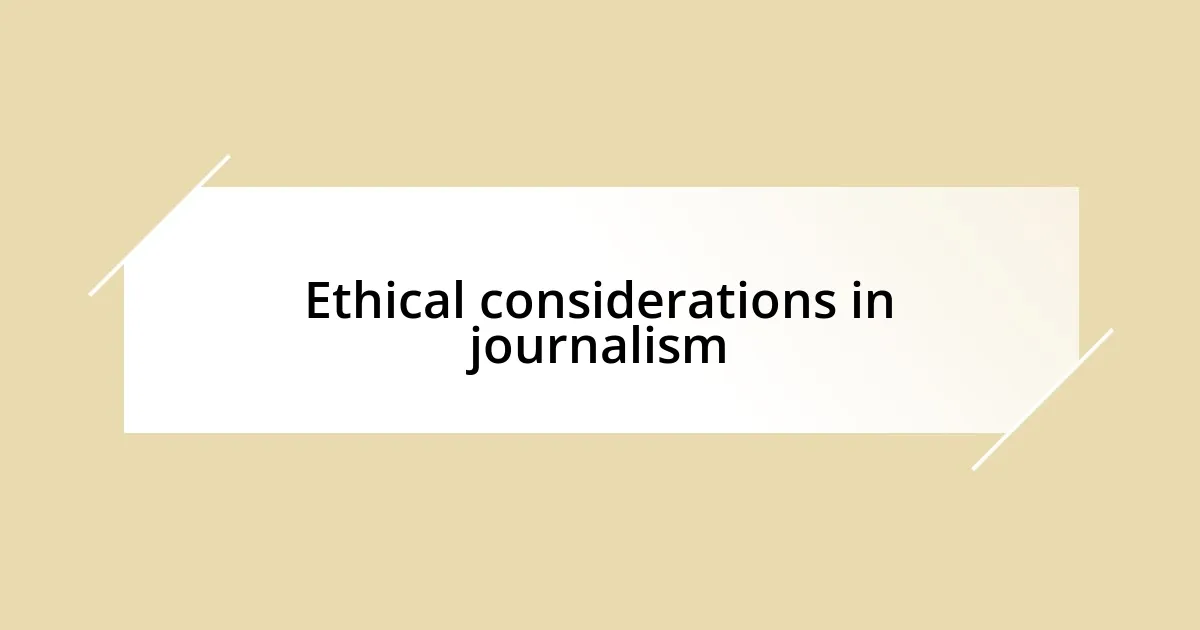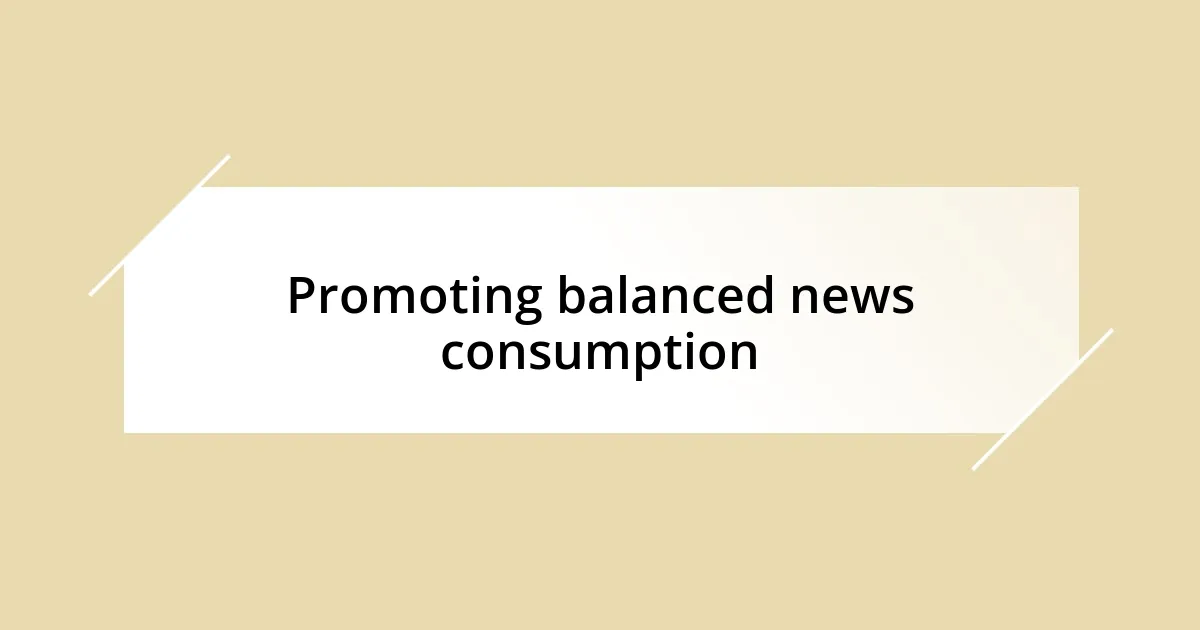Key takeaways:
- Sensationalism in news captivates attention but often distorts reality, leading to misinformed perceptions and emotional reactions.
- It can create societal divisions and desensitize the public to real issues while fostering misinformation.
- Identifying sensationalist headlines involves recognizing exaggerated language, vague statements, and lack of credible sources.
- Promoting media literacy and transparency among journalists can help counter sensationalism and encourage balanced news consumption.

Understanding sensationalism in news
Sensationalism in news is like a double-edged sword; on one side, it captures our attention, but on the other, it can distort reality. I remember scrolling through my news feed one day, spotting an outrageous headline that made me pause. It wasn’t until I clicked through that I realized the actual story was far less dramatic than the bold claims suggested. How often do we fall prey to this kind of catchy but misleading news?
Many news outlets thrive on sensationalism, using it to boost ratings and website clicks. This reality struck me when I saw how a minor incident, like a local protest, was blown out of proportion with images of chaos and frenzied crowds. The emotional impact can be overwhelming. It makes you wonder: are we truly informed, or just entertained by the spectacle of it all?
Furthermore, sensationalism often plays into our fears and biases, shaping public perception in subtle yet profound ways. I’ve found myself questioning the narratives being pushed—are they designed to provoke outrage rather than promote understanding? Engaging with news critically has become essential for me, to sift through the chaos and search for the substance behind the flash.

Effects of sensationalism on society
Sensationalism has the power to skew public perceptions significantly. I recall an instance when a celebrity’s minor legal issue was portrayed as a catastrophic event, leading to widespread panic among fans. The uproar demonstrated how easily misinformation can permeate societal beliefs, creating a ripple effect that influences discussions around accountability and morality.
Moreover, sensationalism can desensitize people to real issues, which is particularly concerning. After binge-watching an array of crime documentaries filled with dramatized content, I started questioning the severity of actual news reports. This blurring of lines between reality and dramatization reflects a societal challenge: how do we discern genuine crises from exaggerated tales designed to titillate rather than inform?
In addition to altering perceptions, sensationalism can foster divisions within society. I distinctly remember online debates turning ugly over a misleading headline related to public policy. Emotion often clouds rational discourse, leading to entrenched positions rather than constructive conversations. It made me realize that sensational news doesn’t merely inform—it can create barriers to understanding and empathy.
| Effects of Sensationalism | Examples |
|---|---|
| Skewed Public Perception | Misinterpretations of legal issues, as seen in celebrity news leading to public panic. |
| Desensitization to Real Issues | Normalization of crime dramatization impacting views on actual crime rates. |
| Fostering Societal Divisions | Inflamed debates over misleading headlines hindering constructive dialogue. |

Identifying sensationalism in headlines
Spotting sensationalism in headlines is often easier than we think if we know what to look for. I recall glancing at a headline that read, “Experts warn of impending apocalypse!” It sounded juicy, but it raised a red flag for me. When headlines invoke extreme language or fear-based phrasing, it often indicates a sensationalist approach designed to trigger an emotional response rather than inform the reader.
Here are some characteristics that can help identify sensationalist headlines:
- Exaggerated Adjectives: Words like “shocking,” “incredible,” or “catastrophic” often signal sensationalism.
- Vague Statements: Headlines that don’t provide specific details may aim to mislead or intrigue rather than inform.
- Fear-Inducing Language: Phrases that evoke anxiety or panic are typically crafted to catch attention, not present facts.
- Lack of Supporting Evidence: If a headline makes bold claims without attributing them to credible sources, skepticism is warranted.
- Polarizing Language: Headlines that create an “us vs. them” scenario generally seek to inflame rather than educate.
In my experience, that moment of pause before clicking on a headline can reveal so much. I remember being drawn to a headline about a “new study proving XYZ.” However, upon reading, it turned out that the study was small and the findings were hardly conclusive. It made me appreciate how crucial it is to be discerning; sometimes, I wonder if we’ve become so conditioned to sensationalism that we forget to pause and think critically about what we’re consuming.

The role of social media
It’s hard to overstate the impact of social media on the spread of sensationalism in news today. I remember scrolling through my feed one evening when a viral post declared, “This shocking revelation will change everything!” Honestly, it caught my attention, but as I delved deeper, I found it was just a recycled opinion piece with little substance. This experience highlighted for me how social media can amplify sensationalist content, prioritizing clicks over accuracy.
Furthermore, social media platforms thrive on engagement, and sensationalism, by its very nature, drives engagement like nothing else. I’ve noticed that posts with bold claims or alarming headlines generate a flurry of comments and shares. In a way, it illustrates a troubling paradox: the more sensational the news, the more it spreads. But does this ultimately enhance our understanding of real issues, or just fill our feeds with noise?
Reflecting on my own behavior, there have been instances where I’ve shared sensational content, only to later feel uneasy about it. Once, I shared a video claiming to unveil a hidden scandal, but as I later learned, the facts were twisted for effect. It made me think—how often do we stop to verify before we spread sensationalism ourselves? That moment of realization nudged me to be more mindful, recognizing that social media, while a powerful tool for connection, can also be a breeding ground for misinformation.

Ethical considerations in journalism
Ethical considerations in journalism are paramount for maintaining trust and credibility. I’ve often pondered the line between capturing attention and promoting irresponsible reporting. For instance, when I encountered a piece that sensationalized a minor event, it left me wondering: how can a journalist balance the need for engagement with their ethical obligation to inform the public accurately?
Moreover, the responsibility to verify facts before publication weighs heavily on reporters. I once read an article that immediately retracted a headline after discovering the information wasn’t substantiated. This left a lasting impression on me; it reinforced the idea that while speed is essential in today’s news cycle, the risk of spreading misinformation far outweighs the need to be first. Isn’t it fascinating how in our quest for timely news, we sometimes overlook the fundamental principles of journalism?
Finally, ethical journalism requires acknowledging the potential harm that sensationalist stories can inflict on individuals and communities. I remember feeling uneasy after reading a sensational report about a local incident that led to panic in my neighborhood. It made me ask myself: should the media be held accountable for the consequences of their narratives? Clearly, the challenge lies not just in reporting the news, but in doing so with a deep sense of integrity and respect for the audience’s intelligence.

Strategies to counter sensationalism
To counter sensationalism in news, one effective strategy is promoting media literacy among the audience. I remember a workshop I attended where we explored tools for evaluating news sources and claims. It was enlightening! I realized that teaching people how to critically analyze what they read can empower them to spot sensationalism more easily. Isn’t it amazing how a little knowledge can go such a long way?
Another key approach is for journalists to embrace transparency in their reporting. I once came across a news outlet that openly shared their fact-checking process, and it instantly built my trust in their stories. When reporters provide insights into how they gather information or cite sources, it encourages a culture of accountability. Have you ever felt reassured when a writer is upfront about their methods?
Lastly, I believe that fostering a community that values thoughtful dialogue can diminish the allure of sensational headlines. I recall joining an online forum where we discussed news stories in depth, rather than just reacting to the headlines. Those conversations often led us to uncover the real stories beneath the sensational surface. Wouldn’t it be wonderful if we all engaged more critically rather than just consuming the headlines mindlessly?

Promoting balanced news consumption
Promoting balanced news consumption requires a proactive approach from both news consumers and producers. I still recall a time when I found myself scrolling through headlines filled with alarming phrases, leading me to react impulsively. It struck me then how easy it is to fall into the trap of sensationalism. Have you ever clicked on a report, only to feel misled once you dug a bit deeper? Taking a moment to question our initial reactions can make a world of difference.
Engaging with diverse news sources can significantly enhance our understanding. I once made a habit of comparing several reports on the same event, and it was eye-opening! The variation in tone and detail often highlighted how a singular perspective can skew the narrative. Isn’t it interesting how much richer our comprehension becomes when we explore different viewpoints?
Creating a personal news intake strategy can also help. I decided to allocate specific times for news consumption, limiting distractions and allowing me to digest information more thoughtfully. This shift helped me prioritize quality over quantity. Have you considered how your approach to news consumption impacts your overall perspective? Finding that balance can transform our relationship with the media.














